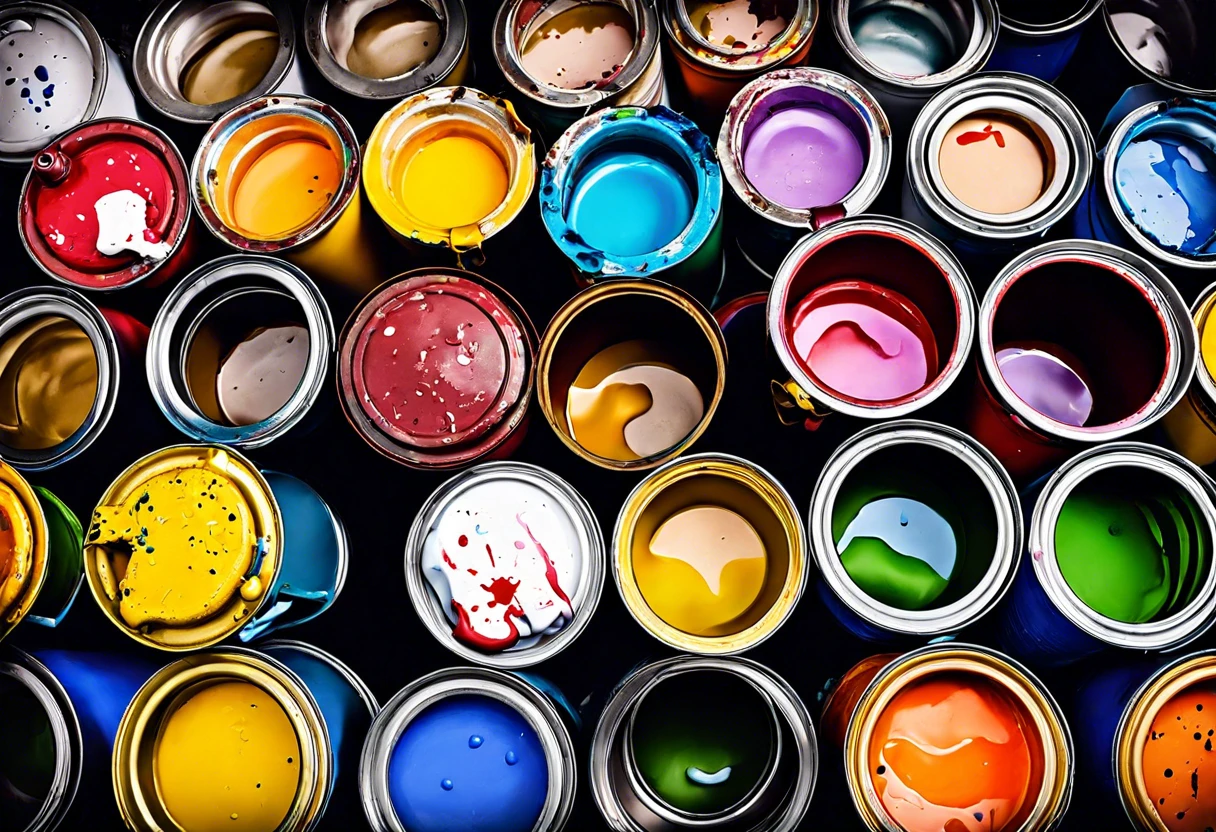Can You Throw Away Empty Paint Cans?
Published on: April 20, 2025 | Last Updated: January 7, 2025
Written By: Sarah McClintock
Paint cans are those shiny metal or plastic containers that hold paint, just like jars hold jam. They might feel heavy when full, but when they’re empty, they’re lighter and ready for your next adventure!
So, can you throw away empty paint cans? It’s super important to figure this out because proper disposal keeps our environment clean. I once tossed an empty can without checking, only to find out later I could’ve recycled it instead—oops!
In this article, you’ll learn about what empty paint cans are, local rules for disposal, steps for safe disposal, types of paint cans, problems during disposal, and even fun DIY projects with old cans. Whether you’re wondering how to dispose of old paint cans or what to do with empty paint cans, I’ve got you covered.
Contents
- 1 Can You Throw Away Empty Paint Cans?
- 2 What Are Paint Cans and Their Uses?
- 3 Before You Start: Understanding Local Regulations
- 4 Steps for Disposing Of Empty Paint Cans Safely
- 5 Types Of Paint Cans: Understanding Your Options
- 6 Factors Affecting Paint Can Disposal Guidelines
- 7 Common Issues When Disposing Of Empty Paint Cans
- 8 Environmental Impact of Throwing Away Empty Paint Cans
- 9 How to Check Local Disposal Options
- 10 Finishing Touches: Ensuring Proper Disposal
- 11 Best Practices for Recycling Empty Paint Cans
- 12 Understanding the Recycling Process for Metal Paint Cans
- 13 FAQ
- 14 Conclusion: Making Responsible Choices for Paint Can Disposal
- 15 Useful Resources
Can You Throw Away Empty Paint Cans?
Yes, you can throw away empty paint cans, but check local guidelines first. Some areas allow this in your regular trash, while others may require recycling or special disposal. Always remove any leftover paint and clean the cans before disposal. If you’re considering painting your bathroom, you might want to explore painting your bathtub surround for a fresh look.
What Are Paint Cans and Their Uses?
Paint cans are containers designed to hold liquid paint. Typically made of steel or plastic, these cans come in various sizes, with common volumes like 0.946 liters (1 Quart) and 3.785 liters (1 Gallon). If you’re curious about exploring alternative paint applications, you might want to explore painting techniques for fabric projects.
Now, about empty paint cans—your experience may vary! I remember finding several old cans in my garage, and it’s tough to decide what to do with them.
When I tackled that project, I realized how crucial it is to know how to dispose of old paint cans properly. You shouldn’t just toss them; instead, think about how to dispose of old paint cans responsibly to avoid environmental issues. It’s essential to check local guidelines; after all, knowing what to do with empty paint cans can save you a headache later! If you’re wondering about specific outdoor painting considerations, acrylic paint’s outdoor durability might provide additional context for your painting projects.
Before You Start: Understanding Local Regulations
What do you need to do before disposing of empty paint cans?
- Safety Gloves: Wear gloves, like Xtreme 4Mil Nitrile Gloves, to protect your hands from paint residues. They’re thick enough to prevent messes.
- Proper Disposal Bags: Use heavy-duty plastic bags, such as Hefty Ultra Strong Bags, to seal and discard any paint-soiled items. This prevents leaks and odors.
- Labeling Tape: Get durable tape, like Duck Brand Easy Riser, to label hazardous materials. This ensures compliance with local regulations and informs others.
- Paint Can Opener: You may need a reliable can opener, like Ewbank Can Opener, for proper disposal. Opening cans relieves pressure and prepares them for recycling.
We have now covered understanding local regulations regarding paint disposal. Next, we’ll discuss safe steps for disposing of empty paint cans.
Also See: Can You Hand Paint a Tractor? Transform Your Machine!

Steps for Disposing Of Empty Paint Cans Safely
Follow these steps for proper disposal of empty paint cans.
-
Determine Local Disposal Guidelines
Check with your local waste management agency for specific rules on paint can disposal. Some areas allow you to throw empty cans in the trash, while others require you to take them to a hazardous waste facility. If you’re working with different types of paint like acrylic, you might want to explore alternative paint applications.
Knowing local rules can save you time and hassle. Many cities have specific hotlines or websites for guidance.
-
Prepare the Empty Paint Cans
If your paint cans are completely dry and empty, leave the lids off or dispose of them as instructed. This allows any remaining vapors to escape, keeping you safe during disposal.
It’s vital to let water-based paints dry completely before discarding to avoid potential dangers.
-
Choose the Right Disposal Method
If local guidelines permit, you can throw the empty paint cans in the trash. Alternatively, take them to a recycling facility that accepts paint cans.
Remember, oil-based paints often require different handling than water-based ones. Keeping these differences in mind is essential!
We covered safe disposal methods for empty paint cans. We will now cover the different types of paint cans available.
Types Of Paint Cans: Understanding Your Options
Let’s discuss types of paint cans: Metal, Plastic, Cardboard, and Aerosol.
-
Metal Cans
Metal cans are the most common type, typically holding 1 quart (0.95 L) to 5 gallons (18.9 L). You can recycle them if they’re completely empty, but most facilities won’t accept partially empty cans. If you’re looking to repurpose old paint containers, you might want to explore creative painting techniques.
-
Plastic Cans
Plastic cans are lighter and easier to handle, holding around 1 to 3 gallons (3.8 To 11.4 L). You typically can’t toss these in regular trash. Local recycling guidelines vary widely.
-
Cardboard Cans
Cardboard cans are eco-friendly alternatives, usually used for specialty paints. Only throw these away when completely empty; otherwise, they contribute to landfill waste.
-
Aerosol Cans
Aerosol cans are pressurized containers. It’s unsafe to toss them in regular trash due to explosion risks. Many disposal centers offer special recycling for aerosol cans.
As someone with experience in the field, I prefer metal cans for their recyclability and sturdiness. They’re easy to handle and often accepted at local recycling centers, making disposal hassle-free!
You should now have a good understanding of the different kinds of paint cans available. In the next part, we’ll discuss the factors influencing paint can disposal rules.
Factors Affecting Paint Can Disposal Guidelines
What factors influence your decision on disposing of empty paint cans?
-
Local Regulations: Some areas have specific laws against disposing of paint cans in the trash.
-
Can Material: Metal cans may be recyclable, while plastic ones might be trash, depending on local recycling options.
-
Residual Paint: Cans with leftover paint usually require special disposal, avoiding regular trash methods.
-
Environmental Concerns: Toxic substances in paint lead to stricter guidelines to prevent pollution during disposal.
That covers the elements influencing paint can disposal guidelines. Let’s now take a look at frequent problems encountered in empty paint can disposal.

Common Issues When Disposing Of Empty Paint Cans
Last year, my friend tossed her empty paint cans in the trash and received a fine. Who knew? Local regulations often restrict this.
To resolve this, check your area’s guidelines. Usually, recycle them or take them to hazardous waste (Hazardous Materials) sites. They’ll know how to dispose of them safely.
Environmental Impact of Throwing Away Empty Paint Cans
Wondering why it matters if you just toss those empty cans? Let’s dive into the real environmental impact of paint can disposal.
-
Waste Accumulation
Over 1.4 billion (1,400 million) paint cans get disposed of each year in the U.S. alone. Many end up in landfills, taking up a lot of space.
-
Toxicity Risks
Many paints contain harmful chemicals. Improper paint disposal can lead to toxic substances leaching into the soil and water. Studies show that paint chemicals can contaminate local water sources, risking human and wildlife health. If you’re working with alternative materials like clay, you might want to explore painting techniques for air-dry clay that minimize environmental impact.
-
Recycling Benefits
Recycling paint cans cuts down on raw material use. For every ton of metal recycled, we save about 1,400 kg of iron ore! That’s a huge win for our planet.
How to Check Local Disposal Options
Looking for specific ways to dispose of empty paint cans in your area? Here’s a simple guide!
| City | Website for Guidelines | Contact Number |
|---|---|---|
| Los Angeles | lacitysan.org | (800) 773-2489 |
| New York City | nyc.gov/recycle | (311) |
| Chicago | chicago.gov/recycling | (312) 744-3566 |
| Houston | houstontx.gov/solidwaste | (832) 395-9050 |
Checking your local waste management resources ensures you’re following the guidelines and keeping the environment safe!
Finishing Touches: Ensuring Proper Disposal
After deciding how to handle empty paint cans, clean the insides thoroughly with a brush and solvent like mineral spirits. Label the cans according to local disposal guidelines.
Inspect for visible damage or leaks, especially near the seams. Note any abnormalities; you can’t have cans contaminating others or hazardous waste. Brands like Rust-Oleum provide clear guidelines. If you’re planning a large-scale painting project, you might want to explore techniques for creating stunning murals.
If you’ve recycled paint before, use a specialized recycling facility that accepts latex and oil-based paints. Check if your area accepts specific plastics like #4 (Low-density Polyethylene).
Best Practices for Recycling Empty Paint Cans
Want to recycle those empty paint cans? Follow these best practices to ensure you’re doing it right!
- Remove All Residue: Before recycling, ensure there’s no paint left inside. Wash out the cans with water or solvent until they’re clean.
- Check Local Recycling Programs: Each location has its guidelines. Find out what’s accepted in your area’s recycling program.
- Disassemble When Possible: If your paint cans have detachable parts, separate them. Metal lids can often be recycled separately from the can itself.
- Use Designated Collection Events: Many communities hold special events for hazardous waste and paint can recycling. Look for those in your area!
Understanding the Recycling Process for Metal Paint Cans
Curious about what happens after you recycle those paint cans? Here’s a simplified overview.
| Step | Description | Environmental Benefit |
|---|---|---|
| Collection | Cans are collected from recycling bins. | Reduces landfill waste. |
| Sorting | At recycling centers, cans are separated from other materials. | Ensures proper processing of materials. |
| Processing | Cans are shredded and melted down into molten metal. | Recycles materials into new products. |
| Manufacturing | New products (like automotive parts) are made from recycled metal. | Conserves natural resources and energy. |
FAQ
Now let’s look at some common questions I typically get asked about paint cans and their disposal.
What Can I Do With Leftover Paint?
You can use leftover paint for touch-ups and small projects. Many homeowners find that just 10% of paint is used for fixes, which can save costs on future projects.
Can I Recycle Empty Paint Cans?
Yes, you can recycle empty paint cans, but ensure they’re completely dry and free from residue. Scrap metal recyclers accept these, and recycling helps reduce landfill waste significantly.
What Should I Do if the Can is Not Completely Empty?
If the can is not completely empty, you shouldn’t throw it out. Instead, allow the paint to dry by using a paint hardener, or mix with cat litter until solid, then dispose of it in trash.
Are There Environmental Risks to Improper Disposal?
Yes, improper disposal of paint cans can lead to environmental risks. Chemistry from leftover paint can seep into soil and water, potentially hurting wildlife and tap water supply.
How Can I Properly Clean Paint Cans Before Disposal?
You can clean paint cans before disposal by scraping out excess paint and rinsing thoroughly with water. Use at least 2 liters of water for a cleaner result and ensure no paint residue remains before recycling. If you’re working with different paint types like oil and acrylic, you’ll want to know the proper techniques for painting over existing layers.
What Are the Best Places to Donate Leftover Paint?
The best places to donate leftover paint include local non-profits, schools, or community projects. By keeping paint in use, you help reduce waste and support local initiatives.
Can I Store Leftover Paint?
Yes, you can store leftover paint for future projects. It typically lasts 10 years if stored properly, in a cool, dry place, and sealed tightly.
Conclusion: Making Responsible Choices for Paint Can Disposal
I hope this was worth your while as we covered essential topics like the uses of paint cans, local regulations, steps for safe disposal, factors that affect disposal guidelines, common issues, and even fun DIY project ideas. We also touched on different types of paint cans and the recommended color palette for your projects.
I trust these insights have been helpful in answering: can you throw away empty paint cans? The straightforward answer is yes, but don’t toss them directly in the trash. Ensure they’re empty and clean before disposing of them, or check local disposal guidelines for eco-friendly options.
For further information and resources on paint disposal techniques, tips, and best practices, visit Paint Answers.
Useful Resources
- Loomis, A. (2011). Figure Drawing for All It’s Worth. New York, NY: Titan Books.
- Old Paint Disposal: What to Do With Latex and Oil-Based Paint
- Household Hazardous Waste | Florida Department of Environmental Protection
- r/bullcity on Reddit: Best way to dispose of old paint cans




